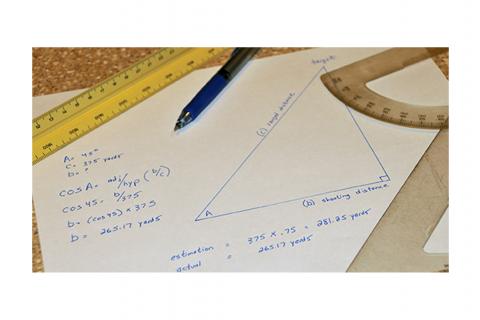
Sometimes a target ranged at 400 yards isn’t actually 400 yards away. At least as far as a bullet is concerned. The fact is, while measured distance is one component of understanding how much to compensate for bullet drop, there is a second component that is often overlooked: the shooting angle.
For most shooting scenarios less than 200 yards, shooting angle isn’t much of an issue.
Flat-shooting calibers from zero to 200 yards have very little drop, so even at an angle of 45 degrees, aiming per usual will yield a typical result.
Where shooting angle has a greater impact is at angles greater than 45 degrees and at distances more than 200 yards.
In these instances it is important to remember that only the horizontal component of the bullet’s path effects the bullet’s trajectory and that using a ranged value might lead to an improper hold. Leaving the science and gravitational-force components to the experts, shooters can utilize a simple, and relatively accurate, method to calculate their true shooting distance for angles 45 degrees or less to get them in the ballpark.
To utilize this quick and dirty method first range the target, then gauge the shooting angle, and lastly do a quick calculation using the percentage rule.
For 30-degree angles, shoot at 90-percent of ranged value
For 45-degree angles, shoot at 75-percent of ranged value
Using a ranged value of 500 yards to help illustrate, a target at a 30-degree angle has a true shooting distance of 433 yards and a quick estimate value of 450 yards. For a target at a 45-degree angle the true shooting distance is 354 yards and the quick estimate is 375 yards. Not exact, but certainly close enough to be effective.
Additionally, don’t worry if the shot is uphill or downhill, the calculation works the same in both directions.

While there are certainly shooting angles of more than 45 degrees in the mountains, using a quick calculation will not be sufficient as the true shooting distance changes significantly with every plus-10 degree change in angle.
For instance, a ranged value of 500 yards is a true shooting distance of 211 yards at a 65-degree angle, and 129 yards at 75 degrees.This is where an angle compensating rangefinder like Cabela's Intensity 1600 Rangefinder comes in handy. The Intensity 1600 rangefinder measures line of sight distance or true horizontal distance to compensate for shooting from elevated positions. Switch modes quickly using the intuitive menu viewed through the high-light-transmission LCD.
In addition to helping shooters understand their hold at severe angles, these rangefinders also provide feedback at every angle and a distance a shot presents itself.
- 16455 views

